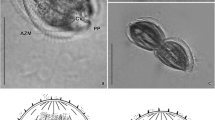Abstract
The developmental cycle of stages ofSphaerospora renicola, proliferating in the walls of the swimbladder in carp fry and responsible for swimbladder inflammation (=SBI stages) is described. The initial stage, a primary cell containing two secondary cells, grows in size while the secondary cells divide and produce two tertiary cells each by endogenous division. After a supposed disintegration of the grown primary cell, the cell triplets are released to repeat the cycle. The cell divisions are asynchronous and the development of the whole formation may be quite irregular. The cytology of these stages is closely reminiscent of the blood stages ofS. renicola and also shares common features with the parasite's sporogonic stages. The SBI stages show typical features of myxosporean organisation, i.e., a “cell-within-cell” arrangement in which the primary cell contains secondary cell(s) in membrane-bound vacuoles and many free ribosomes, in the absence of centrioles. Othersalient features of SBI stages are partitions in the nuclei; a small amount of cytoplasm in the early secondary cells; distinct, age-dependent changes in morphology of the nucleus; and atypically shaped Golgi bodies in the cytoplasm or integrated with the nuclear envelope. The cytological features and significance of swimbladder stages are discussed in detail.
Similar content being viewed by others
Abbreviations
- P :
-
primary cell
- S :
-
secondary cell
- T :
-
tertiary cell
- G :
-
Golgi body
- R :
-
endoplasmic reticulum
- PN :
-
primary cell nucleus
- F :
-
fat reserve
References
Baska F, Molnár K (1988) Blood stages ofSphaerospora spp. (Myxosporea) in cyprinid fishes. Dis Aquat Org 5:23–28
Bucsek JM, Csaba G (1981) Ultrastructural observations on a carp blood parasite of uncertain taxonomic position. In: Oláh J, Molnár K, Jeney Z (eds) Fish, pathogens and environment in European polyculture. Proceedings, International Seminar, June 23–27, Szarvas, Hungary
Csaba G (1976) An unidentifiable extracellular sporozoan parasite from the blood of the carp. Parasitol Hung 9:21–24
Csaba G, Kovács-Gayer E, Békési L, Bucsek M, Szakolcai J, Molnár K (1984) Studies into the possible protozoan aetiology of swimbladder inflammation in carp fry. J Fish Dis 7:39–56
Dyková I, Lom J (1982)Sphaerospora renicola n.sp., a myxosporean from carp kidney, and its pathogenicity. Z Parasitenkd 68:259–268
Grassé PP, Lavette A (1978) La myxosporidieSphaeromyxa sabrazesi et le nouvel embranchement des Myxozoaires (Myxozoa). Recherches sur l'état pluricellulaire primitif et considerations phylogénétiques. Ann Sci Natur Zool Paris 20:193–285
Grupcheva G, Dyková I, Lom J (1985) Seasonal fluctuation in the prevalence ofSphaerospora renicola and myxosporean bloodstream stages in carp fingerlings in Bulgaria. Folia Parasitol (Prague) 32:193–203
Kent ML, Hedrick RP (1986) Development of the PKX myxosporean in rainbow troutSalmo gairdneri. Dis Aquat Org 1:169–182
Körting W (1982) Protozoan parasites associated with swimbladder inflammation (SBI) in young carp. Bull Eur Assoc Fish Pathol 2:25–28
Körting W (1983) Myxozoa as causative agents of swimbladder inflammation (SBI) in carp fry? Parasitology 87:61
Körting W, Hoffman R, Neukirch M, Fuhrmann H (1984) Myxosporidien-bedingte Schwimmblasenentzündung bei Karpfenbrut. Berl Muench Tieraerztl Wochenschr 97:99–104
Kovács-Gayer E (1983) Histopathological studies on protozoan swimbladder inflammation of common carp fry. Parasitol Hung 16:39–46
Kovács-Gayer E, Csaba G, Békési L, Bucsek M, Szakolczai J, Molnár K (1982) Studies on the protozoan etiology of swimbladder inflammation in common carp fry. Bull Eur Assoc Fish Pathol 2:22–24
Lom J (1987) Myxosporea: a new look at long-known parasites of fish. Parasitol Today 3:327–332
Lom J, Dyková I (1985)Hoferellus cyprini Doflein, 1898 from carp kidney, a well established myxosporean species or sequence in the developmental cycle ofSphaerospora renicola Dyková and Lom, 1982. Protistologica 21:195–206
Lom J, Dyková I, Pavlásková M (1983) “Unidentified” mobile protozoans from the blood of carp and some unsolved problems of myxosporean life cycles. J Protozool 30:497–508
Lom J, Pavlásková M, Dyková I (1985) Notes on kidney-infecting species of the genusSphaerospora Thélohan (Myxosporea), including a new speciesS. gobionis sp. nov., and on myxosporean life cycle stages in the blood of some freshwater fish. J Fish Dis 8:221–232
Molnár K (1984) Experimental evidence that protozoans causing swimbladder inflammation in common carp (Cyprinus carpio L) are stages ofSphaerospora renicola. Bull Eur Assoc Fish Pathol 4:14–15
Molnár K (1988a) Further evidence that C blood protozoa of the common carp are stags ofSphaerospora renicola Dyková et Lom, 1982. Bull Eur Assoc Fish Pathol 8:3–4
Molnár K (1988b) Presporogonic development ofSphaerospora renicola Dyková and Lom, 1982 in the swimbladder of the common carp,Cyprinus carpio.. J Fish Dis 11:489–497
Molnár K, Kovács-Gayer E (1986) Experimental induction ofSphaerospora renicola (Myxosporea) infection in common carp (Cyprinus carpio) by transmission of SB-protozoans. J Appl Ichthyol 2:86–94
Molnár K, Csaba G, Kovács-Gayer E (1986) Study of the postulated identity ofHoferellus cyprini (Doflein, 1898) andMitraspora cyprini Fujita, 1912. Acta Vet Hung 34:175–181
Noble ER (1944) Life cycle in the Myxosporidia. Q Rev Biol 19:213–235
Plehn M (1924) Praktikum der Fischkrankheiten. E. Schweizerbartsche, Stuttgart, p 179
Raikov IB (1967) Kariologiya prosteishikh (Karyology of Protozoa). Nauka, Leningrad, p 228 (in Russian)
Ter-Höfte BB, Körting W, Lehman J (1984) C und K-Protozoen, Endoparasiten unsicherer systematischer Zuordnung bei jungen Karpfen (Cyprinus carpio L.). Derzeitiger Wissensstand und bildliche. Dokumentation. In: Fish und Umwelt, vol 13. G. Fisher, Stuttgart New York, pp 89–99
Thiéry JP (1967) Mise en évidence des polysaccharides sur coupes fines en microscopie électronique. J Microsc 6:987–1018
Author information
Authors and Affiliations
Rights and permissions
About this article
Cite this article
Dyková, I., Lom, J. & Körting, W. Light and electron microscopic observations on the swimbladder stages ofSphaerospora renicola, a parasite of carp (Cyprinus carpio). Parasitol Res 76, 228–237 (1990). https://doi.org/10.1007/BF00930819
Accepted:
Issue Date:
DOI: https://doi.org/10.1007/BF00930819




